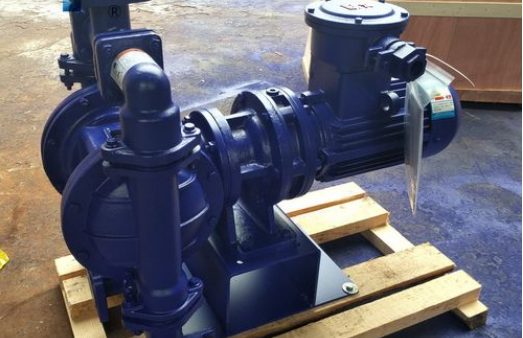Precautions for fluorine-lined electric diaphragm pumps
During the use of the fluorine-lined electric diaphragm pump, you need to pay attention to many aspects to ensure its normal operation and extend its service life. Here are some key precautions:
1. Installation precautions
Installation location: A stable, flat and well-ventilated location should be selected, and the surrounding space should be large enough for daily inspection and maintenance.
Installation foundation: The pump body should be fixed on a horizontal hard ground to ensure that the pump will not move due to vibration during operation.

Connecting pipes:
The pipe should be consistent with the flow rate of the fluorine-lined electric diaphragm pump to avoid the pump's working efficiency being reduced due to the pipe being too thin or too thick.
The diameter of the inlet and outlet pipes shall not be less than the diameter of the pump inlet and outlet. For example, when conveying high-viscosity fluids, the pipe diameter is preferably larger than the pump diameter to facilitate circulation.
The pipes and joints must be sealed, otherwise the self-priming ability of the pump will be reduced.
The shorter the feed inlet pipe, the greater the pump suction force. If it is too long, it may cause the material to not be sucked up. It is recommended to make the suction port oblique to avoid bottoming out and sucking vacuum, causing damage to the diaphragm.
Power supply access: In accordance with relevant standards and requirements, connect the power supply line to the diaphragm pump and ensure that the wiring is firm and reliable. At the same time, the ground wire must be installed during installation to ensure safety.
Liquid level controller setting (optional): If liquid level control is required, the liquid level controller can be installed and set according to actual needs.
Valve setting:
Do not install a valve at the feed inlet. If it must be installed, please be sure to fully open the valve before starting the pump. When closing, turn off the power first, and then close the valve after the pump stops working.
Valves cannot be installed at the discharge port, and pressure relief valves must be installed. The size of the pressure relief valve and the pressure relief pipeline must be consistent with the pump caliber.
2. Operation precautions
Pre-start inspection:
Confirm that the power supply voltage, current, and frequency are consistent with the technical requirements of the pump.
Check whether the inlet and outlet pipes are correctly connected and ensure that all connecting parts are tightened.
Check whether the pump body and pipeline have leakage, blockage and other abnormal conditions.
Start the pump: Turn on the power and press the start button to start the motor.
Adjust the flow rate: According to needs, control the flow rate of the fluid by adjusting the opening and closing degree of the inlet and outlet valves.
Shutdown steps: First close the outlet valve of the pump, then turn off the power supply. Before shutting down, turn off the power supply and drain the residue in the pipeline.
3. Maintenance and care
Regular inspection: The working condition of the pump should be checked regularly. If there is any abnormality, it should be shut down for inspection immediately.
Cleaning and maintenance: Clean the inner and outer surfaces of the pump body regularly to ensure that there is no dust and impurities, and at the same time, pay attention to prevent chemical corrosive substances from contacting the pump body.
Lubrication maintenance: For parts that need lubrication, such as pistons and valves in the pneumatic part, an appropriate amount of lubricating oil or grease should be added regularly. No. 00 lithium-based lubricating oil should be added during the semi-annual inspection of the reducer.
Seal inspection: Regularly check the sealing performance of the diaphragm pump. If leakage or wear is found, the seal should be replaced in time.
Parts replacement: If the internal parts of the pump body are found to be damaged or aged, they should be replaced in time to ensure normal operation.
Antifreeze and heat preservation: When used in winter, attention should be paid to antifreeze and heat preservation to avoid performance degradation or damage of the pump due to low temperature.




